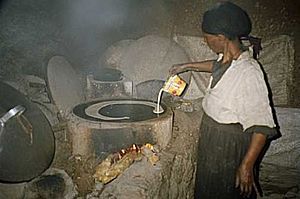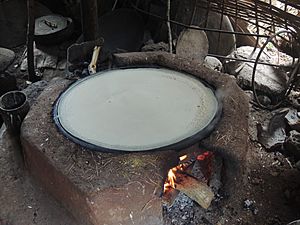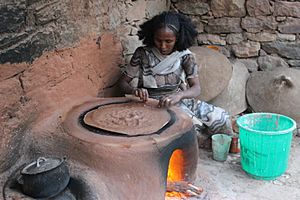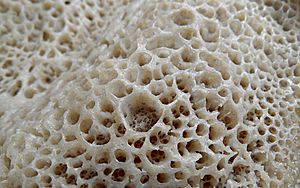Injera facts for kids
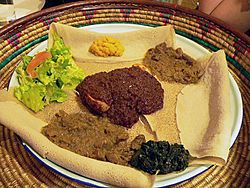
|
|||||||
| Alternative names | Biddeena/Tayta/Tajta | ||||||
|---|---|---|---|---|---|---|---|
| Type | Flatbread or pancake | ||||||
| Place of origin | |||||||
| Region or state | East Africa | ||||||
| Main ingredients | Teff flour (or sometimes wheat, barley, millet, corn, or rice flour) | ||||||
| 131 kcal (548 kJ) | |||||||
|
|||||||
Injera is a special kind of flatbread that looks a bit like a large, thin pancake. It's made from teff flour and has a slightly sour taste and a spongy texture. This comes from a process called fermentation, where tiny living things help the dough rise and develop flavor.
Injera is a very important food in countries like Ethiopia, Eritrea, and parts of Sudan. It's eaten almost every day, much like bread or rice is eaten in other parts of the world.
Contents
What is Injera Made Of?
Traditionally, injera is made with just two simple ingredients: teff flour and water. Teff is an ancient grain that comes from a plant called Eragrostis tef. This plant grows best in the Ethiopian Highlands.
Teff is a special crop, and it can be a bit expensive. Because of this, sometimes other flours like wheat, barley, corn, or rice are mixed with or used instead of teff.
Teff seeds come in different colors. These colors are used to make different kinds of injera. There's nech (white), key or quey (red), and sergegna (mixed). White teff is often seen as more special. Teff flour is also naturally gluten-free.
How Injera is Prepared
To make injera, teff flour is mixed with water. Then, a special starter liquid called ersho is added. This ersho is a clear, yellow liquid collected from previous batches of fermenting teff batter. It contains tiny living things like bacteria and yeasts.
This mixture is then left to ferment for about two to three days. This fermentation process gives injera its unique, mildly sour taste.
Baking Injera
The Baking Method
The way injera is baked hasn't changed much over time. After the flour and water mixture has fermented, it's poured onto a large, round cooking surface. This special griddle is called a mitad.
Injera is baked into big, flat, and round pieces. The dough is runny enough to be poured, which is different from most other breads that are rolled out.
Injera is similar to French crêpes or Indian dosa because it's a round flatbread used as a base for other foods. Its taste and texture are more like a South Indian appam. The bottom of the injera is smooth, but the top is full of tiny holes. These holes are perfect for soaking up sauces and stews!
The Baking Surface
The circular griddle used for baking injera is called a mitad in Amharic or mogogo in Tigrinya. Ancient mitads have been found from as far back as 600 AD. Today, mitads can be made from clay or even be electric.
Traditional clay stoves use a lot of firewood and can create smoke. To make them safer and more efficient, new stove designs have been created. These new stoves can use smaller twigs, crop leftovers, or animal dung as fuel.
Many people, especially those living outside Ethiopia and Eritrea, now use electric injera stoves. These have a large metal plate on top, or they might just use non-stick frying pans.
How Injera is Eaten
In Ethiopia and Eritrea, different stews, salads, and even more injera (called injera firfir) are placed on top of a large piece of injera. To eat, you tear off small pieces of the injera with your hand (usually the right one). Then, you use these pieces to scoop up the stews and salads.
The injera underneath the stews soaks up all the delicious juices and flavors. Once the stews are gone, this flavorful bread is eaten too. So, injera is not just food; it's also your eating utensil and your plate! When all the injera is eaten, the meal is finished.
Injera is eaten daily in almost every home in Ethiopia and Eritrea. Outside these countries, you can find injera in grocery stores and restaurants that serve Ethiopian and Eritrean food.
Injera is the most important part of a meal in Ethiopia and Eritrea. It's often both the serving dish and the tool you use to eat. Hearty stews like wat are placed on top of the bread. Then, you tear off pieces of injera to scoop up the stews.
The meaning of injera can change depending on where you are. In the lowlands of Ethiopia, injera is often made with sorghum. In the highlands, it's more commonly made with barley. When injera is made with grains other than teff, it might be seen as less traditional. Also, white teff is more expensive than red teff, so injera made with white teff can show a higher social status.
Injera Around the World
There are similar flatbreads in other African countries, like Sudan and Chad. The version eaten there is called kisra.
Injera in the United States
Injera became more common in the United States when many Ethiopians moved there in the 1980s and 1990s. This was partly due to the Refugee Act passed in 1980. Now, teff flour is even grown and produced in the United States, making it easier for Ethiopians living abroad to make injera.
See also
 In Spanish: Injera para niños
In Spanish: Injera para niños


